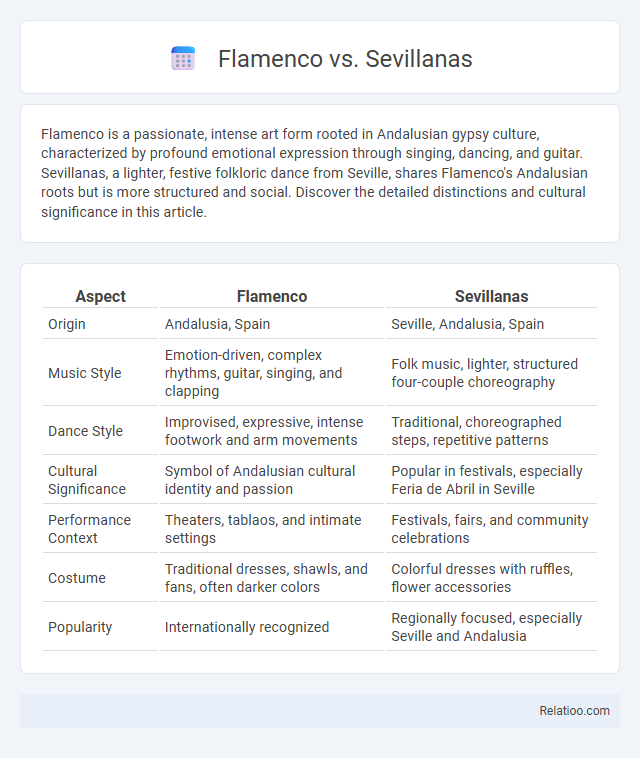Flamenco is a passionate, intense art form rooted in Andalusian gypsy culture, characterized by profound emotional expression through singing, dancing, and guitar. Sevillanas, a lighter, festive folkloric dance from Seville, shares Flamenco's Andalusian roots but is more structured and social. Discover the detailed distinctions and cultural significance in this article.
Table of Comparison
| Aspect | Flamenco | Sevillanas |
|---|---|---|
| Origin | Andalusia, Spain | Seville, Andalusia, Spain |
| Music Style | Emotion-driven, complex rhythms, guitar, singing, and clapping | Folk music, lighter, structured four-couple choreography |
| Dance Style | Improvised, expressive, intense footwork and arm movements | Traditional, choreographed steps, repetitive patterns |
| Cultural Significance | Symbol of Andalusian cultural identity and passion | Popular in festivals, especially Feria de Abril in Seville |
| Performance Context | Theaters, tablaos, and intimate settings | Festivals, fairs, and community celebrations |
| Costume | Traditional dresses, shawls, and fans, often darker colors | Colorful dresses with ruffles, flower accessories |
| Popularity | Internationally recognized | Regionally focused, especially Seville and Andalusia |
Introduction to Flamenco and Sevillanas
Flamenco, rooted in Andalusian culture, combines expressive guitar playing, passionate singing, and intricate footwork to convey intense emotion and storytelling. Sevillanas, a traditional folk dance from Seville, feature structured, rhythmic steps performed in pairs during festivals and celebrations, highlighting social interaction and regional pride. Both dances showcase Spain's rich cultural heritage but differ significantly in style, rhythm, and performance context.
Historical Origins of Flamenco and Sevillanas
Flamenco originates from the Andalusian region of Spain, deeply influenced by the Gypsy, Moorish, and Jewish cultures dating back to the 18th century, reflecting intense emotional expression through intricate guitar playing, singing, and footwork. Sevillanas, a folk dance also rooted in Andalusia, evolved from the traditional jota and fandango, characterized by its lighter, more festive steps commonly performed during local fairs and celebrations. Understanding these distinct historical origins helps Your appreciation of how Flamenco's profound, soulful artistry contrasts with Sevillanas' vibrant community spirit.
Cultural Significance and Influence
Flamenco, originating from Andalusia, Spain, embodies deep cultural significance through its passionate guitar, powerful vocals, and intricate footwork, reflecting Romani, Moorish, and Jewish influences. Sevillanas, a traditional folk dance from Seville performed during festivals like Feria de Abril, emphasizes communal celebration with rhythmic clapping and paired choreography, showcasing regional identity. Both Flamenco and Sevillanas have significantly influenced Spanish dance by preserving cultural heritage, inspiring contemporary choreography, and attracting global appreciation for Spain's artistic traditions.
Musical Structure and Rhythm Comparison
Flamenco features complex compas rhythms with 12-beat cycles emphasizing accents on beats 3, 6, 8, 10, and 12, creating a profound, expressive musical structure rooted in Andalusian culture. Sevillanas are structured in four short coplas with a 6/8 or 3/4 rhythm, maintaining a lively, repetitive pattern ideal for social dance and festivities. Your understanding of these distinct rhythmic frameworks enhances appreciation for Flamenco's intricate, emotive pulse versus Sevillanas' joyful and accessible grooves.
Dance Techniques and Movements
Flamenco features intricate footwork called "zapateado," expressive arm movements, and rhythmic hand clapping known as "palmas," emphasizing emotional intensity and improvisation. Sevillanas incorporate structured, choreographed sequences with graceful turns, coordinated partner interactions, and repetitive patterns, reflecting a festive folk tradition. Both styles utilize posture and body articulation uniquely, with Flamenco prioritizing percussive foot rhythms and Sevillanas focusing on fluid, communal dance formations.
Instruments Used in Flamenco vs Sevillanas
Flamenco primarily features the guitar, cajon, palmas (hand clapping), and sometimes castanets, creating an intense and rhythmic sound that drives the passionate dance. Sevillanas, a folk dance from Seville, often involves simpler instrumentation like the guitar and castanets but leans more towards melodic and accessible rhythms compared to Flamenco. Your appreciation of these dances can deepen by recognizing Flamenco's complex guitar techniques and percussive elements versus Sevillanas' lighter, festive instrumental accompaniment.
Costume Differences in Performances
Flamenco costumes typically feature long, ruffled dresses called "trajes de flamenca," often adorned with polka dots and vibrant colors, emphasizing dramatic movements. Sevillanas dancers wear similar but lighter dresses with shorter skirts and less intricate ruffles to allow for faster, more playful steps during performances. In general dance costumes vary widely but are usually designed for flexibility and can include leotards or tunics, contrasting with the traditional, culturally significant attire seen in Flamenco and Sevillanas.
Social Contexts and Occasions
Flamenco is an intense, expressive dance deeply rooted in Andalusian Romani culture, performed at formal events like tablaos and festivals where emotional storytelling through guitar, singing, and intricate footwork is central. Sevillanas, a lighter and more accessible folk dance, is popular at social celebrations such as the Feria de Abril in Seville, encouraging community participation through simple, rhythmic steps and joyful group performances. Your choice between Flamenco and Sevillanas depends on whether the occasion calls for a dramatic artistic display or a festive, social gathering where dance connects people.
Regional Popularity Across Spain
Flamenco thrives predominantly in Andalusia, especially in cities like Seville, Cadiz, and Jerez de la Frontera, celebrated for its intense emotional expression and complex guitar techniques. Sevillanas, often confused with Flamenco, are a specific folk dance originating from Seville and are much more popular across broader regions during local festivals such as Feria de Abril. Your exploration of Spanish dance culture will reveal that while Flamenco has a deep-rooted association with southern Spain, Sevillanas enjoy widespread popularity throughout the country, often performed at social gatherings and regional celebrations.
Choosing Between Flamenco and Sevillanas
Choosing between Flamenco and Sevillanas depends on your interest in traditional Spanish dance styles; Flamenco emphasizes intense emotional expression with complex guitar riffs, passionate singing, and intricate footwork, while Sevillanas offers a lighter, more social dance with repetitive patterns and festive rhythms often performed at fairs. Your decision should consider Flamenco's deep cultural roots in Andalusia and its status as a highly demanding art form versus Sevillanas' approachable choreography ideal for group celebrations and beginners. Understanding these distinctions helps you select the dance style that best aligns with your personal taste and commitment level.

Infographic: Flamenco vs Sevillanas
 relatioo.com
relatioo.com